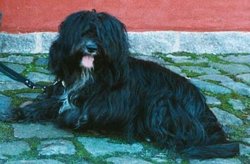Tibetan Terrier
The Tibetan Terrier is not a member of the terrier group, the name being given to it by European travelers to Tibet who were reminded of terriers from back home when they first encountered the breed. more...
Its origins are uncertain at best, as some sources claim them to be lucky temple dogs, whereas others place them as general use farm dogs.
The Tibetan Terrier is a dog with many uses, able to guard, herd, and also be a suitable companion dog. Their utility in Tibet meant that the first examples of the breed available in the west were generally given as gifts, as the Tibetan Terrier, along with other Tibetan breeds, were too valuable to the people who owned them to casually sell. As such, the early history of the breed is linked to only a handful of foundation dogs.
Appearance
The appearance of the Tibetan Terrier is that of a powerful, medium sized dog of square proportions, with a shaggy coat. Overall, there should be a feel of balance.
The head is moderate, with a strong muzzle of medium length, and a skull neither rounded nor flat. The eyes are large, dark, and set fairly far apart. The V-shaped drop ears are well feathered, and should be set high on the sides of the skull. The nose is always black, regardless of coat colour.
The body is well muscled and compact. The length of the back should be equal to the height at the withers, giving the breed its typical square look. Height for either sex is 14-16 in (35-41 cm) and weight is 18-30 lbs (8-14 kg), with 20-24 lbs (9.5-11 kg) preferred, but all weights acceptable if in proportion to the size.
The tail is set high, well feathered, and carried in a curl over the back.
One of the more unusual features of the Tibetan Terrier is the broad, flat feet, not found in any other dog breed. They are ideal for climbing mountains and act as natural snow shoes.
Coat
The double coat is profuse, with a warm undercoat and a topcoat which has the texture of human hair. It should not be silky or curled, but wavy is acceptable. Long and thick, it is shown natural, but should not be so long as to touch the floor, as is typical in breeds such as the Lhasa Apso or Maltese. A fall of hair covers the face and eyes, but long eyelashes generally prevent hair from getting in the Tibetan Terrier's eyes, and the breed has very good eyesight.
Colour
All colours are permissible, barring liver and chocolate, and none are preferred. Tibetan Terriers are available in any combination of solid, particolour, tricolour, brindle or piebald, as long as the nose leather is black and the eyes and eye rims are dark.
Temperament
The temperament has been one of the most attractive aspects of the breed since it was first established in the 1920's. They are amiable and affectionate family dogs, sensitive to their owners and gentle with older children. As is fitting a dog formerly used as a watch dog, they tend to be reserved around strangers, but should never be aggressive nor shy with them.
Read more at Wikipedia.org



